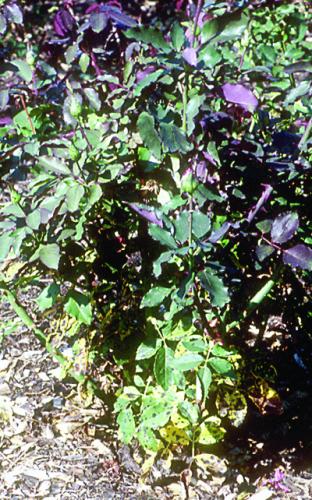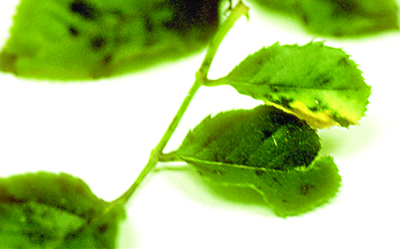Black spot
July 30, 2015
Cause
Diplocarpon rosae (fungus)
Host
Roses
Symptoms
This fungal disease gets its common name from the symptoms produced on the leaves. Infected leaves drop off. Defoliation is worse in hot, humid weather. Leaf petioles, twigs, and canes may also be infected.

Symptoms of black spot begin on the lower leaves and progress upward; the fungus overwinters on infected leaves and canes.
How it’s spread
Splashing rain spreads the spores.
Management
At least seven hours of continuous leaf wetness with temperatures above 68°F are needed for spore germination. Use trickle irrigation or water early in the day to allow roses to dry quickly. Plant the roses in sunny locations with good air circulation. Rake up and destroy infected leaves; prune out infected canes before new growth starts in spring. Choose resistant cultivars where possible. Roses vary widely in their susceptibility to black spot; many hybrid teas, particularly yellow and orange roses, are particularly susceptible to black spot.

Leaf symptoms, showing irregular black spots with fringed margins. Yellow halos develop as the disease symptoms progress.
Although black spot isn’t fatal, the disease can defoliate and weaken susceptible cultivars. Several fungicides are labeled for control.
Resistance
Roses reported resistant to black spot include: Rosa wichuriana, R. roxburgii and some of the R. rugosa hybrids. Consult a current reference for a more complete listing of resistant cultivars and hybrids. Suggested reference for more detailed information on managing roses: Healthy Roses: Environmentally Friendly Ways to Manage Pests and Disorders in Your Garden and Landscape. Flint, M. L., and J. F. Karlik. 2000. Oakland: University of California ANR Publication 21589.
Print a PDF of this page: Black spot



 Print
Print Email
Email



